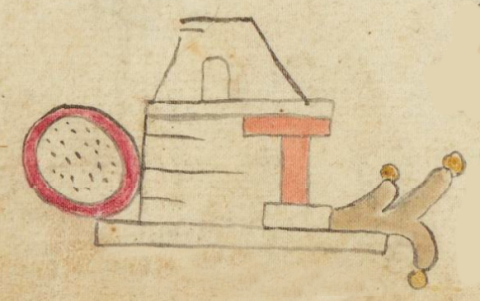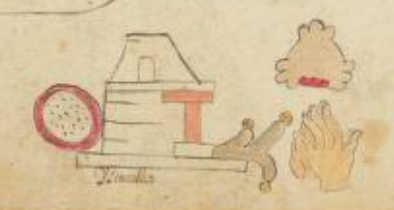Iztacalcan (Azca18)
This painted black-line drawing of the compound glyph for the place name Iztacalcan (perhaps “Place of the Salt House”) shows a circle with dots inside and a red border, seeming representing salt (iztatl). Next to the circle is a building (calli) where salt was probably made from salt water. Water (atl) comes out of the building. This could be just a semantic indicator for the salt making process, but it could also be a phonetic complement to the “-atl” of iztatl.
Stephanie Wood
See the other two compound glyphs for Iztacalco (a similar place name) below. They show somewhat more of the processing of salt using water and heat (indicated by smoke curls coming out of the buildings).
Stephanie Wood
Yztacallcan
Iztacalcan
Stephanie Wood
post-1550, possibly from the early seventeenth century.
Jeff Haskett-Wood
sal, casas, edificios, arquitectura, pueblos, topónimos, nombres de lugares

izta(tl), salt, https://nahuatl.wired-humanities.org/content/
cal(li), house or building, https://nahuatl.wired-humanities.org/content/calli
-can (locative suffix), where, https://nahuatl.wired-humanities.org/content/can-2
En la Casa Donde Fabrican Sal
Stephanie Wood
The Codex Azcatitlan is also known as the Histoire mexicaine, [Manuscrit] Mexicain 59–64. It is housed in the Bibliothèque Nationale de France, and hosted on line by the World Digital Library and the Library of Congress, which is “unaware of any copyright or other restrictions in the World Digital Library Collection.”
https://www.loc.gov/resource/gdcwdl.wdl_15280/?sp=18&st=image
The Library of Congress is “unaware of any copyright or other restrictions in the World Digital Library Collection.” But please cite Bibliothèque Nationale de France and this Visual Lexicon of Aztec Hieroglyphs.




